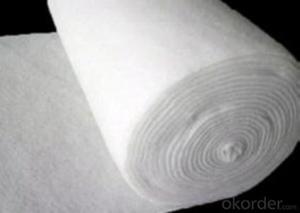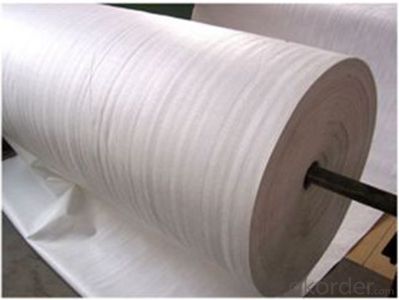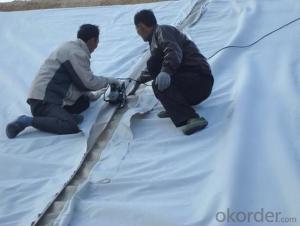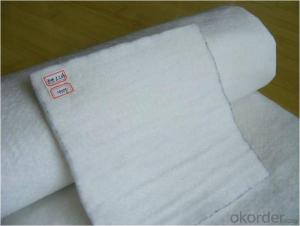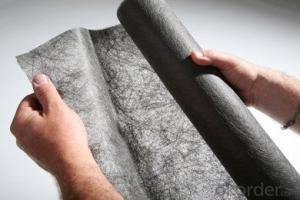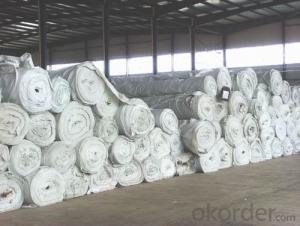Pet Filament Fiber Non-Woven Geotextile Membrane for French Drain Highway and Railway
- Loading Port:
- China main port
- Payment Terms:
- TT OR LC
- Min Order Qty:
- 1000 m²
- Supply Capability:
- 500000 m²/month
OKorder Service Pledge
OKorder Financial Service
You Might Also Like
Specification
PP/PET non woven geotextile,used as earthework material and engineering fabric.width 1-6m,thickness:0.9-6.5mm.weight:100-1200gsm
Our geotextile can be made of polypropylene (PP) or polyester(PET),The weight is available from 100g/m2 to 1200g/m2 and the width from 1m to 6m,Two kinds of processing technical to select: needle punched and thermally bonded.long fiber or short fiber.All kinds of colors are available.Our annual production ability is 20 million square meters.
It is widely known as earthwork material and industry fabric,used in the areas of railway,highway,water conservancy,dam,tunnel,subway,environment protection and so on.
We can supply different specifications as customers`s request.
1 Filtration
The filtration layer of the dykes,river canal, seacoast, concrete slope, retaining walls. At the same time of preventing the clay granule from passing, it allows the water and the gas pass through freely.
2 Separation:
The isolation of the railway dregs and the roadbed, roadbed and the soft base, surface of the airdrome and parking lot and the groundsill, different dam materials. It isolates the soil and the gravel of two kinds different granule pathway from the groundsill or other buildings.
3 Adding muscle:
The highway, railway, soil-stone dam, breakwater, airport, backfill soil of retaining wall, slope protection, etc in which distributes the earth stress, prevents the side-displacement of the earth body and improves the earth body stability.
4 Protection
It prevents the bank from being washed out, protects the bank and the bottom, prevents the water and soil from being washed away.
Detailed Images

Packaging & Shipping
Packing: PLASTIC FILM INSIDE, AND WOVEN BAG OUTSIDE
Shipping: About 15 days after receipt the deposit
pecifications
geotextile fabric
permeability,filtration,easy for construction
ISO and CE certificate
Good quality and competitive price
Our Service
Quality assurance
1.On a regular basis or as per your request,we entrust national testing agencies to conduct quality inspections
2. Strictly in accordance with the ISO9001-2008 international quality system standard,we monitor and manage the whole process throughout production,quality testing,and measurement to ensure product quality
3. For quality-related construction delay or substandard construction(except for damage or losses due to customer’s responsibility or irresistible natural disasters),we have refunding,replacement,and repair services.We will respond to customers’ feedbacks on quality issues within 24 hours.
After-sales service
1.In order to provide customers with comprehensive technical support,we will provide technical and other related information upon request in a timely manner.
2.In required,we will appoint specialized technicians to the construction site to give technical trainings to construction people,and offer technical guidance throughout the whole construction process.
3.For damage due to shipment and delivery,after we receive the complaint,we will check the issure through provided pictures and videos.If our responsibility is confirmed,we wil offer free replacement.
4.When the construction is completed,as your request,our technical staff may participate in the final acceptance.
FAQ:
Q: What kind of payments does jenor support?
A: T/T, L/C, Cash are accepted.
Q: Do you charge for the samples?
A: Accordeing to our company policy, the samples are free, we only charge the freight fee. And we will return the freight fee during the next order.
Q: Can you produce according to customers' design?
A: Sure, we are professional manufacturer, OEM and ODM are both welcome.
Q: Do you have other products?
A: Yes, please check the pictures:
- Q: Can geotextiles be used in coastal dune stabilization projects?
- Yes, geotextiles can be used in coastal dune stabilization projects. Geotextiles are commonly used in such projects to create barriers that help prevent erosion, promote vegetation growth, and provide stabilization to the dune system. They can effectively control sand movement, prevent sand loss, and enhance the stability and resilience of coastal dunes.
- Q: What are the different types of geotextile installation equipment?
- There are several types of geotextile installation equipment, including but not limited to: 1. Geotextile rollers: These are used to unroll and distribute geotextile fabric smoothly and evenly over the intended area. 2. Geotextile sewing machines: These machines are specifically designed to sew together overlapping sections of geotextile fabric, ensuring a secure and durable installation. 3. Geotextile staplers: These handheld tools are used to secure geotextile fabric to the ground or other surfaces using staples, providing additional stability and preventing shifting. 4. Geotextile cutting tools: These can include scissors, utility knives, or specialized cutting devices, which are used to trim and shape geotextile fabric as needed during installation. 5. Geotextile tensioning devices: These devices are used to apply tension to geotextile fabric during installation, ensuring it remains taut and properly positioned. Overall, these different types of geotextile installation equipment are essential in achieving effective and efficient geotextile installation for various applications.
- Q: The technical parameters of woven geotextile
- Test items / specifications 0400 Remarks breaking strength (longitudinal) KN / m ≥ 17. Breaking strength (horizontal) KN / m ≥ no special requirements by the meridional 0.7 / 1 longitudinal and transverse elongation at break% ≤ 25 vertical and horizontal trapezoidal torn Strength, KN ≥ 0.180.200.270.340.410.480.600.72 vertical and horizontal CBR top breaking strength, KN ≥ 1.41.62.43.24.04.86.07.5 equivalent aperture O95 (O95) mm0.07-0.5 vertical permeability coefficient cm / sK × (10-1-10-4) K = 1.0-9.9
- Q: Are geotextiles resistant to chemicals?
- Yes, geotextiles are generally resistant to a wide range of chemicals.
- Q: Composite geotextile 20-500-0.5 what it means
- Should be 200 / 0.5 / 200,200g cloth, o.5 film, wish smooth
- Q: Can geotextiles be used for reinforcement of road embankments?
- Yes, geotextiles can be used for the reinforcement of road embankments. Geotextiles are commonly employed in road construction and maintenance to enhance the stability and durability of embankments. They provide reinforcement by distributing loads and reducing settlement, while also improving drainage and preventing erosion.
- Q: Construction Technology of Seepage Control of Geotextile for Landscape Water System
- Laying HDPE geomembrane should try to weld at least, in ensuring the quality of the premise, as far as possible to save raw materials. But also easy to ensure quality. The lap width of the joint between the membrane and the membrane is generally not less than 10 cm, usually in the direction of the weld arrangement parallel to the maximum slope, that is, along the slope direction. Geomembrane thickness of not less than 0.25mm, too thin may produce pores, and easy to damage in the construction and reduce the anti-seepage effect. Geomembrane construction, in particular, should pay attention to laying should not be too tight, not wrinkled, stitching to be strong. Should be strictly in accordance with technical specifications construction, the good preparation, laying, splicing, inspection and backfill, such as five quality off. I specialize in production and construction
- Q: What are the applications of geotextiles?
- Geotextiles have a wide range of applications in civil engineering and environmental projects. They are commonly used in road construction, where they provide stability, erosion control, and reinforcement. Geotextiles are also utilized in landfills to separate and protect soil layers, preventing contamination. Additionally, they are employed in coastal engineering to mitigate erosion and stabilize shorelines. Geotextiles are also used in drainage systems, agriculture, and landscaping to control erosion, filter water, and promote vegetation growth.
- Q: Can geotextiles be used in the construction of artificial islands?
- Yes, geotextiles can be used in the construction of artificial islands. Geotextiles are permeable fabrics that can provide effective soil stabilization, erosion control, and filtration. They can be used as a protective layer between the island's foundation and the surrounding water, preventing erosion and promoting stability. Additionally, geotextiles can assist in the drainage system of the island, allowing excess water to flow through while retaining the soil. Thus, geotextiles are a valuable tool in the construction and maintenance of artificial islands.
- Q: How do geotextiles help in reducing the impact of heavy rainfall on soil?
- Geotextiles help in reducing the impact of heavy rainfall on soil by acting as a barrier between the soil and the water. They provide reinforcement to the soil, preventing erosion and soil displacement caused by the force of the rainfall. Additionally, geotextiles allow water to infiltrate into the soil and drain efficiently, reducing the risk of waterlogging and improving the overall stability of the soil during heavy rainfall events.
Send your message to us
Pet Filament Fiber Non-Woven Geotextile Membrane for French Drain Highway and Railway
- Loading Port:
- China main port
- Payment Terms:
- TT OR LC
- Min Order Qty:
- 1000 m²
- Supply Capability:
- 500000 m²/month
OKorder Service Pledge
OKorder Financial Service
Similar products
Hot products
Hot Searches
Related keywords



